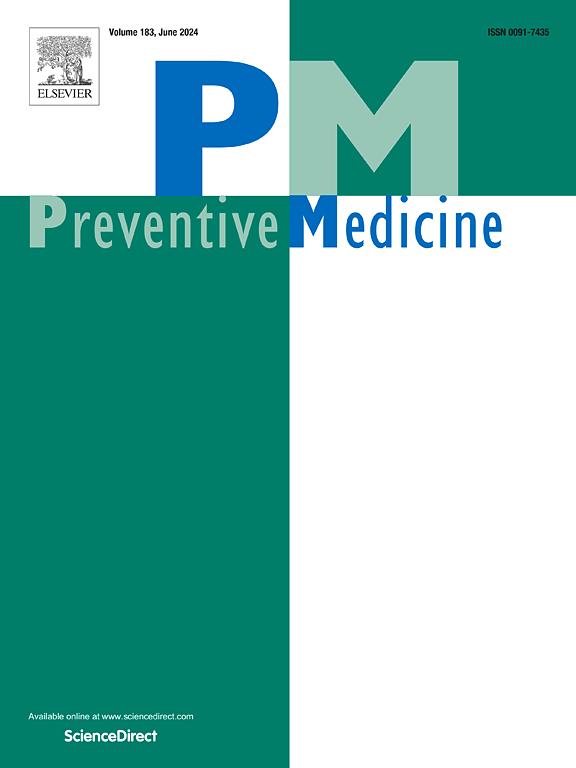Changes in smokers' responses to novel efficacy messages inside cigarette packages following Canada's 2024 labeling policy update: A pre-post longitudinal study
IF 4.3
2区 医学
Q1 MEDICINE, GENERAL & INTERNAL
引用次数: 0
Abstract
Objective
Evaluate the impact of Canada's innovative inside-pack efficacy messages about cessation benefits and tips to quit, whose content was updated in 2024.
Methods
We analyzed data from an open cohort of Canadian adults who smoke, surveyed every three months from February 2023 to November 2024 (n = 12,022 observations, 4716 individuals). At each survey, participants reported the frequency of reading health messages inside packs in the past 30 days (Never/Rarely = reference vs Sometimes/Often/Very often); perceived cessation benefits from inside-pack messages (Not at all-Extremely); forgoing cigarettes due to inside-pack messages in the prior 30 days (No = reference vs Yes); and confidence/self-efficacy to quit smoking (Not at all–Extremely). Linear and logistic generalized estimating equation models regressed these outcomes on implementation period (pre- vs post-implementation surveys). Analyzing participants followed to the subsequent survey (n = 6959 observations, 2356 individuals), mixed-effects logistic models regressed quit attempts in the three-month interval since the prior survey on message responses from the prior survey. All models adjusted for sociodemographics, smoking-related variables, and post-stratification weights.
Results
Self-reported reading inside-pack messages (OR = 1.18; 95 %CI = 1.04, 1.34), perceived cessation benefits (β = 0.07; 95 %CI = 0.01, 0.12), forgoing cigarettes (OR = 1.14; 95 %CI = 1.01, 1.28), and self-efficacy (β = 0.08; 95 %CI = 0.04, 0.13) all increased from pre-to post-implementation. Participants who reported reading messages more frequently (OR = 1.54; 95 %CI = 1.09–2.00), perceived greater cessation benefits (OR = 1.31; 95 %CI = 1.22, 1.42), forwent cigarettes (OR = 1.88; 95 %CI = 1.48, 2.37) and had greater self-efficacy (OR = 1.32; 95 %CI = 1.19, 1.47) were more likely to quit at followup.
Conclusions
After Canada implemented new efficacy messages inside packs, message engagement and predictors of cessation behaviors increased. Other countries may consider similar policies.
加拿大2024年标签政策更新后,吸烟者对香烟包装内新功效信息的反应变化:一项前后纵向研究
目的评估加拿大创新的戒烟益处和戒烟提示内包装功效信息的影响,其内容于2024年更新。方法:我们分析了加拿大成年人吸烟的开放队列数据,该队列从2023年2月至2024年11月每三个月进行一次调查(n = 12022次观察,4716人)。在每次调查中,参与者报告了过去30天内阅读包装内健康信息的频率(从不/很少=参考vs有时/经常/非常经常);从包装内的信息中感知到戒烟的好处(根本没有);在过去30天内因烟盒内的信息而放弃吸烟(否=参考vs是);以及戒烟的自信/自我效能感(完全没有)。线性和logistic广义估计方程模型对实施期间(实施前后调查)的这些结果进行了回归。分析后续调查的参与者(n = 6959个观察值,2356个人),混合效应logistic模型回归了自上次调查以来三个月间隔内的戒烟尝试。所有模型均根据社会人口统计学、吸烟相关变量和分层后权重进行了调整。结果自述阅读包装内信息(OR = 1.18;95% CI = 1.04, 1.34),感知到的戒烟益处(β = 0.07;95% CI = 0.01, 0.12),戒烟(OR = 1.14;95% CI = 1.01, 1.28),和自我效能感(β= 0.08;95% CI = 0.04, 0.13),实施前后均增高。报告更频繁阅读信息的参与者(OR = 1.54;95% CI = 1.09-2.00),感知到更大的戒烟益处(OR = 1.31;95% CI = 1.22, 1.42),谢绝香烟(OR = 1.88;95% CI = 1.48, 2.37)和更高的自我效能感(OR = 1.32;95% CI = 1.19, 1.47)更有可能在随访时戒烟。结论:加拿大在包装内实施新的疗效信息后,信息参与度和戒烟行为预测因子增加。其他国家可能会考虑类似的政策。
本文章由计算机程序翻译,如有差异,请以英文原文为准。
求助全文
约1分钟内获得全文
求助全文
来源期刊

Preventive medicine
医学-公共卫生、环境卫生与职业卫生
CiteScore
7.70
自引率
3.90%
发文量
0
审稿时长
42 days
期刊介绍:
Founded in 1972 by Ernst Wynder, Preventive Medicine is an international scholarly journal that provides prompt publication of original articles on the science and practice of disease prevention, health promotion, and public health policymaking. Preventive Medicine aims to reward innovation. It will favor insightful observational studies, thoughtful explorations of health data, unsuspected new angles for existing hypotheses, robust randomized controlled trials, and impartial systematic reviews. Preventive Medicine''s ultimate goal is to publish research that will have an impact on the work of practitioners of disease prevention and health promotion, as well as of related disciplines.
 求助内容:
求助内容: 应助结果提醒方式:
应助结果提醒方式:


